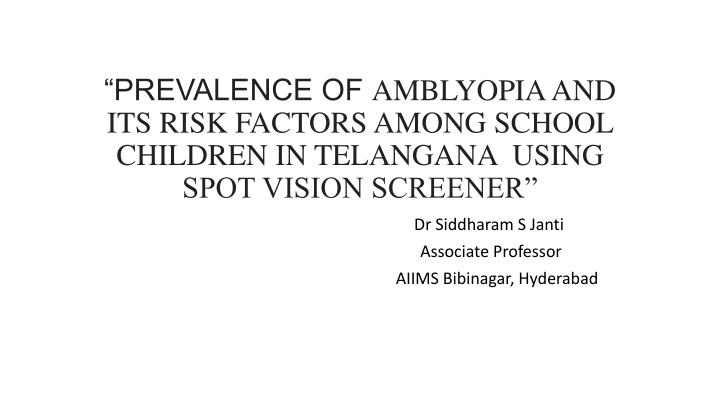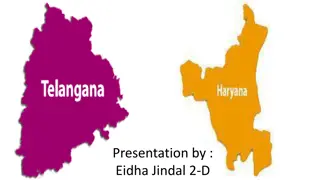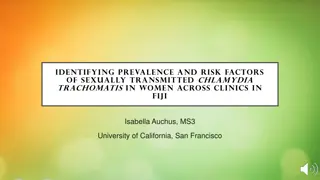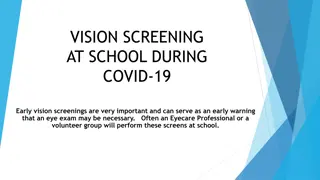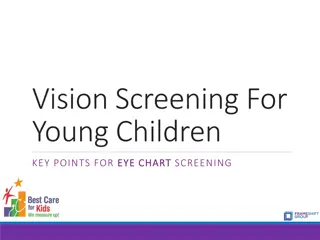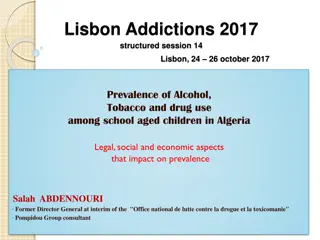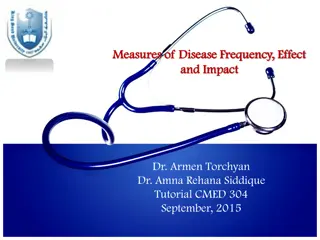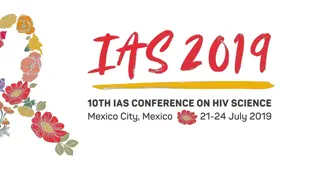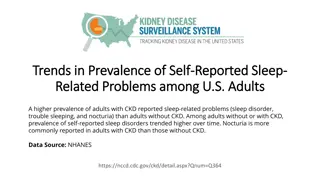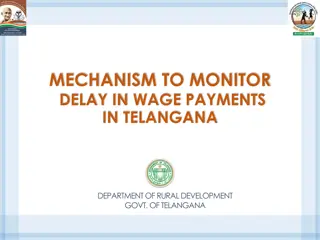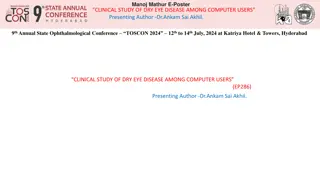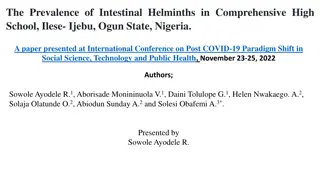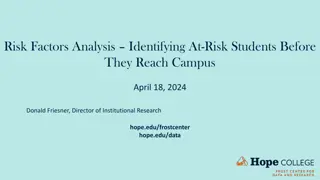Prevalence of Amblyopia and Risk Factors Among School Children in Telangana
The study aims to determine the prevalence of amblyopia and its risk factors among school children in rural areas of Telangana using spot vision screener. A sample of 369 children aged 5-10 years was screened, with 84 children showing amblyogenic risk factors. Out of these, 65 children were diagnosed with amblyopia. Various refractive errors and types of amblyopia were identified, with a majority having myopic refractive error. Children with amblyopia were referred for further management to tertiary healthcare centers.
Download Presentation

Please find below an Image/Link to download the presentation.
The content on the website is provided AS IS for your information and personal use only. It may not be sold, licensed, or shared on other websites without obtaining consent from the author.If you encounter any issues during the download, it is possible that the publisher has removed the file from their server.
You are allowed to download the files provided on this website for personal or commercial use, subject to the condition that they are used lawfully. All files are the property of their respective owners.
The content on the website is provided AS IS for your information and personal use only. It may not be sold, licensed, or shared on other websites without obtaining consent from the author.
E N D
Presentation Transcript
PREVALENCE OF AMBLYOPIA AND ITS RISK FACTORS AMONG SCHOOL CHILDREN IN TELANGANA USING SPOT VISION SCREENER Dr Siddharam S Janti Associate Professor AIIMS Bibinagar, Hyderabad
AIMS AND OBJECTIVES To study the prevalence of Amblyopia among school children in Rural areas of Telangana using spot vision screener. To study Amblyopic risk factors among school children in Rural areas of Telangana using spot vision screener.
MATERIAL AND METHODS: Type of study Cross-sectional study. Study population 5-10 years old school going children in rural area of Telangana. Study area Schools of rural area of Telangana. Sample Size A sample size of 369 children has been considered for study using the Z2PQ/e2 with z value 1.96 , P value of 4 % and absolute precision of 2 % from previous study. Total 714 children are screened for amblyopia and evaluation of risk factors in our study . Inclusion Criteria- Age 5- 10 years School children. Both genders of selected school students. Exclusion criteria- Children with non-vision threatening conditions such as conjunctivitis, hordeolum and allergic conditions will be excluded. Students who are not willing to participate in the study.
The study is conducted in school going children in rural Telangana after informed consent obtained from parents or principle of the school . All students are tested with spot vision screener. The screener is held approximately 3 feet from the subject while the child looks at the display of twinkling light. When data capture is about to start, the screen displays the child's face, a spinning circle, and information about how near or how far away the subject. The typical time for data gathering is two seconds. A report of pupillary diameter, ocular alignment, estimated binocular refraction will b displayed. The Spot provides an interpretation all measurements within range or complete eye exam recommended when refractive errors like astigmatism +1.00 diopters (D) or greater, myopia 0.75 D or greater, and hyperopia +2.00 D or greater and non-refractive like significant media opacity and strabismus greater than 8 PD according to the AAPOS guidelines. Later all screened children are examined by optometrist to verify the diagnosis of amblyopic risk factors . The Children with refractive error , strabismus and visual deprivation amblyopia referred to tertiary health care center for further management .
Results 714 children are screened by using spot vision screener, 84 children showed amblyogenic risk factors when examined with spot vision screener out of which 65 children (9.10%) were found to have amblyopia by ophthalmologist examination. Out of 65 children with amblyopia, 35(54%) were males and 30 (46%) were females. Out of 65 children with amblyopia, Age group of the children diagnosed with amblyopia, 36(55%) were 5-8 years and 29 (45%) were 8-10 years age group . Out of 65 children with amblyopia, number of children with myopic Refractive Error are 45 (69%) , Hypermetropic Refractive Error are 6 and with astigmatism are 14 . Out of 65 children with amblyopia, number of children with refractive amblyopia are 61 (93.84%), strabismic amblyopia are 3 (4.61%), Visual deprived amblyopia are 1 (1.5%).
Sensitivity and specificity of spot vision screener Total Number of children screened 714 84 students reported referral from spot vision screener True positive 65 False positive 19 False negative 9 True negative 630 Sensitivity TP/TP+FN= 65/74 = 87.83% Specificity TN/TN+FP= 621/640= 97.03% Sensitivity 87.83 and specificity 97.03% of the spot vision screener
CONCLUSION This study underscores the importance of regular vision screening, especially in rural areas where access to eye care services may be limited. Early detection and appropriate management of amblyopia and its risk factors can significantly contribute to reducing the burden of preventable vision impairment among children. The Spot Vision Screener, with its noninvasive and efficient screening capabilities, has emerged as a valuable tool in detecting amblyopic risk factors, particularly in resource-limited settings.
